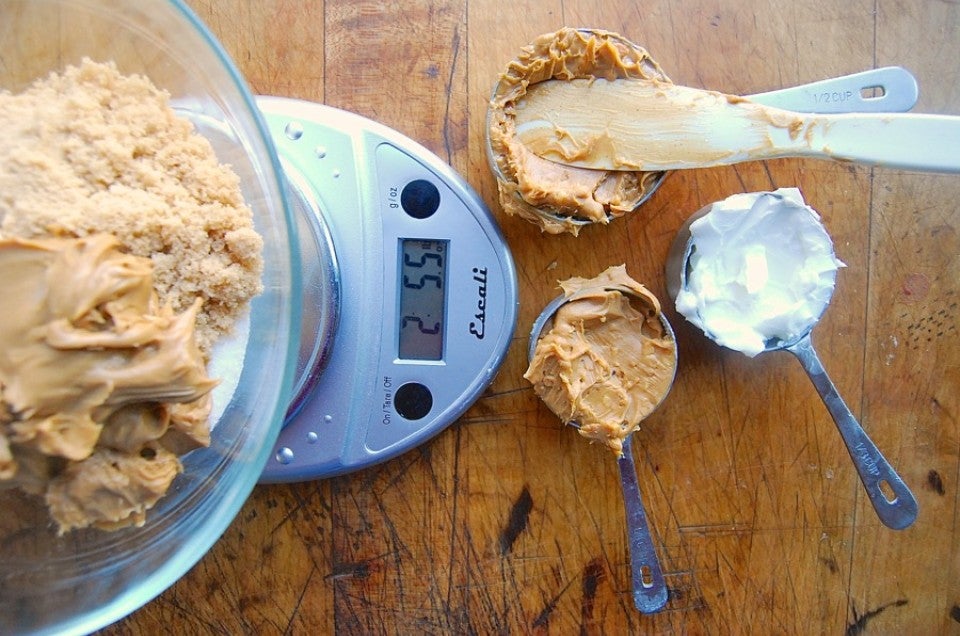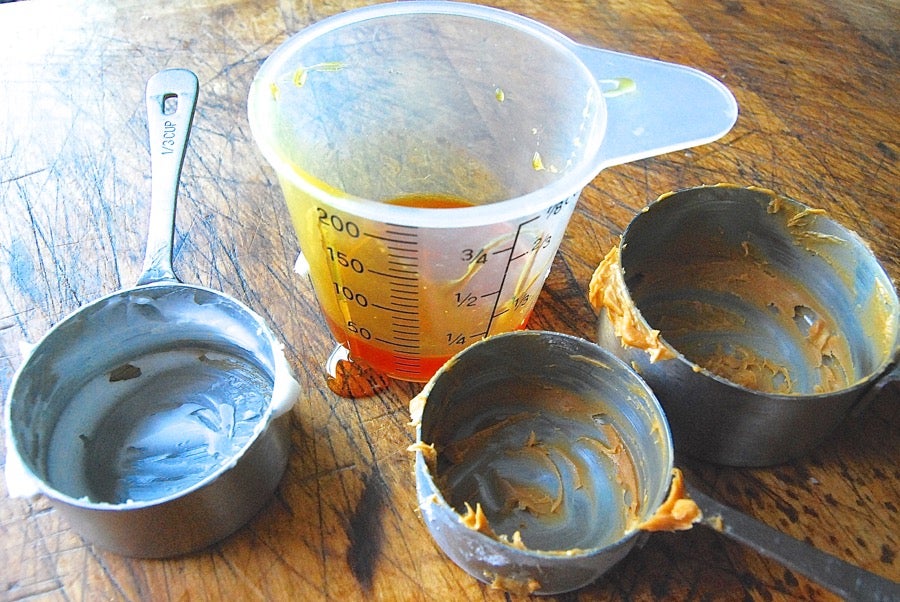


All right, I'm not usually this adamant, but I'm going to come right out and say it:
For best success, measure your ingredients with a scale, rather than measuring cups.
Hey, don't get me wrong. I know home bakers got along without scales for centuries.
Then again, we also got along without food processors and mixers, accurately calibrated ovens and digital thermometers and silicone spatulas. But isn't life in the kitchen easier – and food prep more pleasant – with these useful tools?
If you absolutely, positively love using your mom's measuring cups to bake a loaf of bread, then stick with them. They're a happy memento of the hours you and Mom spent in the kitchen together, a nostalgic connection to your earlier, simpler life.
But if you're interested in saving time; cutting back on cleanup; and almost certainly enjoying more consistent baking success, then I highly recommend baking with a scale.
It just might be the best $29.95 investment you've made in quite some time.
Here's why –
Fill a series of measuring cups with ingredients. Level them off. Scrape contents into the mixing bowl.
Or, scoop ingredients directly from the jar or canister into the mixing bowl.
Your choice.
First, how accurate are your liquid measuring cups? Do the test to find out.
See these two cups? I poured 6 ounces of water into each. The cup on the left looks fairly accurate. The one on the right? Not so much.
Second, while dry measuring cups are more likely to be accurate than liquid measuring cups (with their sometimes random line markings), a lot depends on how you fill the cup.
Do you scoop and tamp? Level off the top, or just kind of give it a shake? There's about 2 tablespoons difference between the cocoa in the cup on the left, and the one on the right.
We've found when measuring flour, the difference can be even more extreme… up to 3 to 4 tablespoons per cup. That means you might be adding up to 3/4 cup additional flour to a typical bread recipe. OUCH! Talk about dry, tough bread... For more on that, please see how to measure flour for best success.
Think muffins. Do you totally nail your portioning every single time. Or do you end up with some muffins small and pitiful looking – and some mushroom-capped and overflowing their cups?
Here's what to do for muffins, layer cakes, cookies, or any time you want to portion your dough or batter into finished treats that are all the same size:
•Know the weight of your mixing bowl before you start.
•Once you've mixed up your batter, put the bowl on the scale and weigh it.
•Subtract the weight of the bowl, to establish the weight of the batter.
•Do some simple arithmetic: divide the weight of the batter by the number of portions the recipe calls for (e.g., 12 muffins; 24 cupcakes; 2 round cake layers).
•Scoop out that amount of batter for each muffin (or cake layer, etc.)
The result? As you can see, pretty darned nice.
OK, I know you're wondering: these are our Doughnut Muffins (prior to their "dip" in melted butter and cinnamon-sugar), made into both mini muffins, and standard-size.
Serendipitously, the recipe makes the perfect amount of batter for 20 minis and six standards; I knew that ahead of time, because I weighed the batter. [Pats self on back.]

OK, you decide you want 18 muffins, instead of 12. Well, that's easy – just multiply everything by 1 1/2, right?
This Doughnut Muffin recipe calls for 1/4 cup each butter and vegetable oil; 1/2 cup granulated sugar, and 1/3 cup brown sugar.
Rather than get into multiplying fractions, I simply use gram amounts for each ingredient, do the basic arithmetic, then weigh everything into the bowl.
Or, if I didn't have a scale – "Hmmm, 1/4 x 1 1/2 = 3/8 cup. That's kind of between 1/3 and 1/2, isn't it? Or maybe I should use the 1/4-cup and fill it 1 1/2 times..." See how measuring by volume can lead you down the slippery slope to inaccuracy?

Is this what you typically end up with at the end of a relaxing, enjoyable baking project? Sink time, right? Or at a minimum, dishwasher space.
When you weigh ingredients, there are no measuring cups to clean. Full stop.
And that's where I'll leave you, as I go on to finish these peanut butter cookies I've been using as a demonstration. Just remember, my muffins and cookies turned out great – and I won't be washing any sticky measuring cups. Will you?
Do you use a scale for baking? Weigh in! Tell us in comments (below) why you bake with a scale.


September 25, 2023 at 11:39am
For some reason, when I weigh my ingredients I always end up with too wet a dough--it doesn't matter what recipe it is! I'm taring my scale and all that good stuff--any idea what I could be doing wrong???
September 25, 2023 at 2:50pm
In reply to For some reason, when I… by Dave Nelson (not verified)
Hi Dave, I suspect this might have to do with how you've been accustomed to measuring flour by cups before you started weighing your ingredients. If you typically scooped your flour into the cup, this tends to yield a much heavier cup of flour, which won't match up with the weight we assign to a cup of our Unbleached All-Purpose Flour or Bread Flour (120g/4.25 ounces). To arrive at that weight, we use this method to measure a cup of flour. When baking some of your favorite recipes, you're bound to notice that the batter or dough seems much wetter than it used to.
Another possible cause would be if you tried to substitute another type of All-Purpose or Bread flour in place of the flour we call for in our recipes. Here the wetness might be the result of using a lower protein flour, which will absorb less liquid.
November 8, 2022 at 12:36pm
I love using my scale and measuring my ingredients for all the reasons PJ discusses. However, one of the challenges I had as I went from measuring cups to the scale was converting old recipes I had made for years. I used conversion charts but that didn't always work, especially with flour. Many times the results were not good. So this is what I did and it has worked well for me. When using an old recipe and converting it to weights, I would measure my flour, etc, the "old way" using measuring cups. Then I would weigh the flour and write the weight in grams in my cookbook or on my old recipe card. From then on, I could use the weight measurement and be sure my baking results would be consistent with what I had come to expect through the years. So if you are having trouble converting old recipes, give this a try.
November 12, 2022 at 2:39pm
In reply to I love using my scale and… by sandy (not verified)
Great idea, Sandy! Thanks for sharing.
September 21, 2022 at 4:41pm
Please, specifically in ounces....4 cups of King Arthur Whole Wheat Flour equals how many ounces. Thank you and hoping for success 🙏..please help...Im desperate, lol.
September 23, 2022 at 5:19pm
In reply to Please, specifically in… by Margaret (not verified)
Hi Margaret, 4 cups of whole wheat flour is equal to 16 ounces. Happy Baking!
January 23, 2021 at 5:52pm
I am a lab chemist and I am confused by the values listed for some items in the Ingredient Weight Chart on your website. Some of the weights that are listed disagree with standards established by the National Institute of Standards (NIST). For example, the weight listed for 1 cup (8 oz) of water is 227 g. This is the weight of water if it was 8 oz dry weight. However, the NIST defines 1 fluid ounce as 29.57 mL. The density of water is 1 g/mL so 1 fl oz of water is equivalent to 29.57 g of water and 8 fl oz of water is equivalent to 236.6 mL or 237 g. Most measuring cups especially those meant for liquids like Pyrex, will contain 237 g of water at the 8 oz mark.
In the same vein, the weight given for vegetable oil does not seem right. Most vegetable oils have a density of 0.92, so 1 cup (8 fl oz) of oil should weigh 218 g instead of 198 g (236.6 g × 0.92). It seems the 198 g value may be based on the dry weight instead of the fluid ounce.
This may not matter much but the oil weight discrepancy is 10% and the water weight discrepancy is 4%. Are the weights given in the recipes on your website based off these values or on the actual weight used when developing the recipe?
January 24, 2021 at 3:49pm
In reply to I am a lab chemist and I am… by Jeff (not verified)
Hi, Jeff! We occasionally hear from scientists such as yourself who are confused about the difference. The standards used in the baking community and the scientific community differ on a number of things, this being one of them. You'll find the weight of water, for example, to be quite stable across all cookbooks and recipe sites.
January 24, 2021 at 6:30pm
In reply to Hi, Jeff! We occasionally… by kmayerovitch
Hi Kat,
Thank you for the reply. My concern is that non-scientists (who may be less likely to use a scale) will grab their measuring cups and fill them up with a different amount than what the recipe was tested. I prefer using weights and the scale does make cleanup much easier. The scientific community doesn’t use the US Customary System, so I thankfully never had to convert from cups! I find the US Customary System unnecessarily complicated, especially the difference between an avoirdupois (dry) ounce and fluid ounce; I wish the we would finally adopt the metric system so we could stop using cups and teaspoons.
March 26, 2023 at 7:37am
In reply to I am a lab chemist and I am… by Jeff (not verified)
Can someone comment on this? Because King Arthur recipes have been confusing me about this. I always thought water's molecular density was a convenient 1g/mL, so I always measure 240 grams (easier than 236) of water for one cup. But since using King Arthur recipes I've been confused about the 227 value always used.
I've seen many places make the 8 ounces (mass) vs 8 (fluid) ounces mistake, but that seems silly for a company like this
Pagination